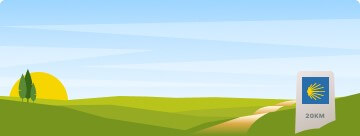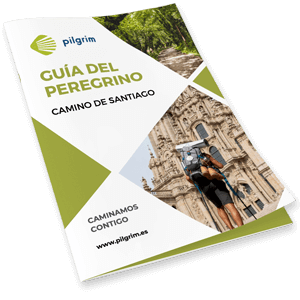Camino del Norte: Stage 23
- Home
- ❯
- All the paths
- ❯
- Northern Way
- ❯
- Northern Way: Stage 23 – Soto de Luíña – Cadavedo | Pilgrim
Soto de Luiña – Cadavedo (23 km – 14 miles)
This stage is a little bit longer than 20 kilometers and you will have different alternatives to get to the end: you can get to Cadavedo through the road and then get into the Sierra de Palancas mountain pass. Cadavedo is a lovely place with wonderful landscapes such as the Playa de la Ribeirona beach or the Ermita de la Regalina hermitage.

You will start this twenty-first stage getting to the national road. Once you get to the first crossing you will have to make a decision: continue through the original way crossing the Sierra de las Palancas mountain pass or continue through the asphalted road, an alternative way. The original way is the most complicate one due to its difficulty and also to the bad conditions of it. If you decide to go through the original route you will continue through the mountain to walk through the forest, through narrow paths. In winter it will be impossible walk through the original way.
If you decide to go through the original route you will continue through the mountain to walk through the forest, through narrow paths. You will have to cross some small rivers, and you will have to be very careful. You will be walking among eucalyptus and chestnut trees in the forests called Picu y Mediu, Ablanéu and El Cierru’l Cura. You will ascend more and more leaving behind the small coastal villages. You will walk through Cuesta de la Ventana where the wind will be by your side. You will walk through Cuesta de la Ventana where the wind will be by your side. There are some markers that are a little bit hidden but if you pay attention you will see them. You will be near many villages on your way, but you won’t go through any of them. You will start walking up again through paths. Once you get to the top you will see Novellana, a place where you will see the pilgrims that are doing a route called Bellotas. A little bit after you will have to go down towards the road in Silvaoscura and Las Ventas. After a curve you will see some indications that will indicate you to go through the route called El Camino de las Bellotas; going through the Ermita de San Roque hermitage or continue walking up through a mountain path. You will see El Picu Paradiel and also a viaduct called Pintor Dionisio Fierros. A little bit after the indications will be a little bit confusing. Once you get to a crossing you will have to keep walking up, following the yellow Enagás posts. While you are walking up you will see a marker that will indicate you that you have to go to the right and finally you will get to Picu Paradiel. Then you will see a yellow arrow that will indicate you that you have to go to the right before walking up again. You will see a lonely house once you get to Valdés, and also the Cantabrian Sea again. You will have to go down to get again to the coast. You will go among pine trees and the indications will be better. You will keep going down through Picu Cabornín’s slopes to get to La Rodiella and then you will get to a road that will lead you to San Pelayo de Tehona. Once you get to the next crossing you will have to cross the road and walk up towards a route that starts on the right side. The best option is to continue to the right, through the road to get to Cadavéu.
This second option is a little bit easier, it goes through the national road. You will have to continue through the N-632. After 4 kilometers you will get to Albuerne, that belongs to Cudillero and famous due to its beach called Gancéu. Este arenal está protegido por unos altos acantilados y catalogada como Paisaje Protegido. You will have to get then to Novellana and Castañeras that also belong to Cudillero. In Castañeras you will find one of the best beaches in Asturias: Playa del Silencio. This wonderful beach is a little bit hidden and unknown to tourists. This wonderful beach is a little bit hidden and unknown to tourists. Then you will continue to Santa Marina and then to Ballota where you will leave the asphalted road to get to some rural paths. You will have to cross the Cabo river through a bridge known as Le Pont qui Tremble. It was the name that pilgrims gave to this bridge that firstly was built with wood. Before getting to Cadavedo you will have to cross a forest called Tabalizo that is full of chestnut trees, holly trees, oak trees… this route could be a little bit difficult in some seasons.
What to see
Remember.
We walk by your side! If you have any doubts about this stage or about other stages, please contact us, we will help you. Have a nice Way, pilgrim!
What to eat
- Sopa de pixín (typical fish soup)
- Calderetas de pescados y mariscos
- Fabada asturiana (typical bean stew)
- Empanadas de angulas, caballa, solomillo…
- Cider
Bear in mind
If the weather is bad we recommend you to go through the national road, but if you are traveling in summer the best option is to go through the mountain because you will enjoy the wonderful landscape. Cyclists and people with reduced mobility should go through the national road.
What to see| Towns | Public Hostel |
Bike rental |
Medical assistance |
Coffe bar |
Teller |
Pharmacy |
Hotel |
Touristic Information |
Guesthouse |
Restaurant |
Supermarket |
Veterinarian |
|---|---|---|---|---|---|---|---|---|---|---|---|---|
| Soto de Luíña |  |
 |
 |
 |
 |
 |
 |
 |
 |
 |
||
| Novellana |  |
 |
 |
 |
||||||||
| Castañeras |  |
 |
 |
|||||||||
| Santa Marina |  |
 |
 |
 |
||||||||
| Ballota |  |
 |
 |
 |
||||||||
| Cadavedo |  |
 |
 |
 |
 |
 |
 |
 |
Towns


